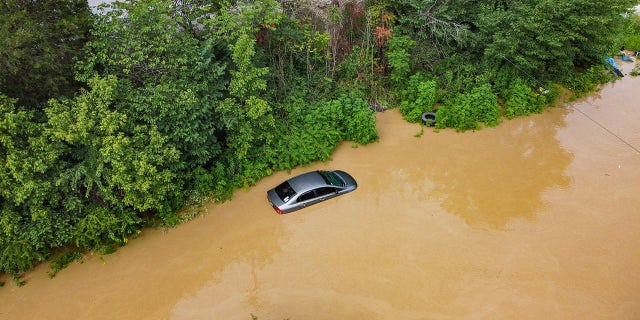
Car caught in flash flood? Follow these 3 survival tips
Throughout the United States, weather-related floods can often cause long-term damage to property and lead to the loss of life.
Floods are among the most common weather disasters, and the bill to repair your vehicle from flood damage can often be expensive. After a vehicle has been involved in a flood, people are recommended to assess the damage before starting the car back up.
However, avoiding floods can sometimes be an impossible task under certain circumstances. Whether near riverbeds or in dry deserts hit by storms, roads can quickly become inundated and give drivers little time to react.
LIGHTNING STRIKES RAM PICKUP IN FLORIDA. HERE’S WHY THE PASSENGERS SURVIVED
Dozens of Americans die each year in this scenario, and in Australia, which has many areas that are susceptible to flash floods, the local automobile safety rating organization is planning to add an evaluation that aims to determine how long systems like electric windows remain operational when the vehicle is submerged.
While the National Weather Service’s “Turn Around Don’t Drown” campaign advises drivers to avoid going through standing water at all times, it’s possible to find water rushing toward a vehicle and leaving nowhere to turn toward safety.
Mike Berna is a regional director and instructor with the Rescue 3 International group, which provides training to emergency services. In August 2022, he shared several simple survival steps with Fox News Autos that drivers should keep in mind when they find themselves in a flooded area.
- Keep away from water that can flow more than halfway up your tires
- Try getting to the roof
- If you slip, grab onto material not moving in the water

The Kentucky River in Jackson, Kentucky, overflowed its banks on July 28, 2022, and flooded surrounding roads. (Leandro Lozada / AFP via Getty Images / File)
1. Keep away from water that can flow more than halfway up your tires
Berna said to never drive through water that’s more than halfway up your tires, regardless of the type of vehicle you’re in. That’s deep enough to cause it to float and be swept away.
“First, you should undo your seat belt in case the vehicle flips over,” he said, “but don’t immediately exit the vehicle because your chances of surviving a fast-moving flood are reduced when you are floating in the water unprotected.” It’s best to crack a window open before the power is lost, rather than roll it all the way down, which will help keep water out of the cabin while making the glass easier to break, if necessary.
CLICK HERE TO SIGN UP FOR OUR LIFESTYLE NEWSLETTER
Moreover, remaining calm during this situation is essential because making rash decisions out of fear may only serve to further endanger your life. During this period, if you are caught in water that is more than halfway up your tires, it may be difficult to escape because of the water pressure from the outside.
If you are in a situation where you are in a flood but not inside a vehicle, you should keep your feet downstream and try to avoid moving objects in the water such as tree branches or other debris.
2. Try getting to the roof
Once the vehicle starts filling up with water, however, it’s time to start thinking about getting out and getting onto the roof rather than swimming away. This will keep you better protected and make it easier for rescuers to spot you than if you’re just bobbing in the water alone, Berna said.
You’ll have to roll the window down now or break it by striking a bottom corner with something hard. A small window hammer tool is good to keep in a vehicle if you live in a flood-prone area, but you can also remove the front-seat headrest and use the posts to smash the glass.
Vehicles as large as trucks can be swept away by fast-moving floodwater. (Arden S. Barnes for the Washington Post via Getty Images/File)
The damage caused by smashing the window is insignificant because when the water reaches the threshold to cover your car, the pressure may cause the windows to break either way.
In addition, seeking higher ground in a flood is recommended whether you are on top of a vehicle or not. Once rescuers arrive, follow their directions and remain calm to avoid any serious injury or loss of life.
3. If you slip, grab onto material not moving in the water
After that, Berna said to pull out the seat belt to use as a hand-hold in case you slip, then to use the seat, armrest and windowsill as steps to get to the roof.
If you slip off at that point, or if the vehicle becomes completely submerged, he said to either swim to the nearest high ground or to grab onto something solid that’s not moving in the water.
A window hammer has a sharp, metallic point designed to break glass. (Jules Annan / Avalon / Getty Images / File)
Berna’s best advice, however, is to keep track of emergency warnings in any wet-weather emergency and heed them immediately. People are able to receive notifications about real-time emergency warnings in their local area via the FEMA app, which provides the ability to find emergency shelters and provides preparedness strategies.
CLICK HERE TO GET THE FOX NEWS APP
The National Weather Service also allows people to track real-time weather emergencies in five locations at the same time.
“Evacuate the area as soon as possible,” Berna said.
“Once the flooding starts, it might be too late.”